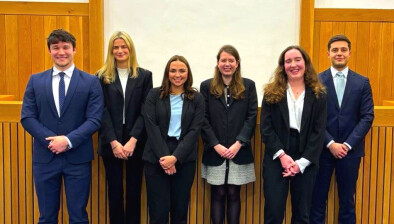Analysis: Considerations for the entertainment industry after the SAG-AFTRA deal

David Cullen and Roisin Culligan
William Fry partner David Cullen and associate Roisin Culligan analyse the recent SAG-AFTRA deal for those operating in Ireland, in light of its importance as a location for the entertainment industry.
Last year, entertainment industry output was hit by a 118-day strike, until eventually a deal was brokered and the resulting agreement was ratified between the key representative bodies, the Screen Actors Guild-American Federation of Television and Radio Artists (SAG-AFTRA) and the Alliance of Motion Picture and Television Producers (AMPTP).
A prominent issue in the dispute related to concerns about how AI would be used in the industry. The deal provides actors with broad protections in relation to AI replicating their image and likeness.
Although the agreement applies to members of SAG-AFTRA in the United States, it can be expected to be used as a benchmark elsewhere. Ireland has long been an attractive location for the entertainment industry. This article analyses the SAG-AFTRA deal, in particular with respect to its AI provisions.
What are the key AI provisions under the SAG-AFTRA agreement?
Much of the dispute between the parties revolved around the use of AI to copy an actors’ image/likeness. The agreement reached contains a broad range of provisions that protect against actors’ digital image/likenesses being used without consent and compensation.
Under the agreement, studios will have the ability to create two different types of “digital replicas” of real actors: employment based digital replicas (EBDR) and independently created digital replicas (ICDR).
EBDRs are replicas made with the actors’ participation, using scans or other such technology, in connection with employment in a project — think of Andy Serkis as Gollum in the Lord of the Rings franchise.
ICDRs are independently created digital replicas, often created using existing material and used to portray the actor in scenes in which they didn’t actually participate — such as Carrie Fisher as Leia in Star Wars: The Rise of Skywalker.
EBDRs v ICDRs
The agreement includes provisions for consent and compensation for use of digital replicas. For both types of digital replicas, studios will have to provide a “reasonably specific description” of their intended use and actors (or presumably their estates for posthumous use) will have to provide clear and express consent.
- For EBDRs, consent will have to be given by actors well in advance of having their likeness captured. Actors will be paid for the initial scan of their likeness and for EBDR replicas, actors must also be paid for the days they would have had to work in person, if a digital replica is being used. Furthermore, in most cases, actors will be owed residual payments, for when work using their EBDR is re-broadcast or re-used. However, this is not the case for so-called Schedule F performers (performers who make over US$80,000 for a film), who will have to negotiate their own terms.
- In the case of ICDRs however, consent provisions are not as strong, and actors will have to negotiate payment for residuals with studios on a case-by-case basis.
A notable aspect of the agreement is a consent requirement for the use of dead actors’ images. Under California law, the estates of actors can control the use of the actors’ names and likenesses for 70 years after their death. However, this is limited to commercial endorsements, so it does not apply to “expressive works” such as films.
Generative AI (GAI)
The provisions of the agreement relating to GAI have attracted some criticism and were the subject of considerable differences.
GAI refers to a subset of AI that learns patterns from data and produces content. One of SAG-AFTRA’s main concerns with the use of GAI related to use of an actor’s movements, actions and facial expressions as training data for “synthetic performers” (digital creations using GAI). This provision specifically excludes CGI and VFX.
If producers plan to create a synthetic performer that clearly resembles a real actor and that actor’s face is used to prompt the GAI system to do this, they must first obtain permission from that actor and agree on how this character will be used in the project. Studios will have to notify SAG-AFTRA of an intention to produce a project using GAI instead of a real actor and offer the union an “opportunity to bargain in good faith” to give real life actors a chance to audition for the roles. There is no substantive guidance on what this bargaining process should entail.
SAG-AFTRA did not obtain a blanket ban on actors’ performances being used as training data. The agreement notes that the two sides will meet regularly to discuss remuneration terms, if any. There are concerns expressed by some that this type of GAI could displace (or at least reduce significantly) the need for human labour in the industry. This of particular concern, given the fact that intellectual property laws are generally not suitable to protect against this, unless an actor’s image or identity is clearly incorporated in the actual output.
Although the agreement’s protections on AI are extensive, our analysis noted a number of gaps. There are quite broad exceptions and caveats to consent provisions. For example, studios do not need to seek consent “if they would be protected by the First Amendment”, which could be used to bypass the consent requirement. Actress Justine Bateman, AI adviser to the SAG-AFTRA negotiating committee, expressed concern that this could result in actors finding themselves in a project to which they didn’t consent, doing things of which they weren’t informed, all for no compensation. Another gap in the agreement is the lack of consent needed for a digital replica if “the photography or sound track remains substantially as scripted, performed and/or recorded”.
Existing legal protections available in relation to image rights in the US and Ireland
The new AI provisions under the agreement should enhance the legal protections available including those for performers in the industry, who are seeking to protect their image and likeness. Key protections available and the interplay with the new agreement can be summarised as follows.
The right to publicity
In the United States, the deal negotiated will complement the right to publicity currently available to actors in certain states. In many states in the US, including California and New York, the right to publicity allows actors and celebrities to control the use of their name, image and likeness for commercial purposes. The right to publicity also extends to deceased individuals and can be enforced by their estate under the Astaire Celebrity Image Protection Act.
There is a further statutory exemption for use of a deceased person’s image or likeness in a work that is either fictional or non-fictional entertainment, or alternatively, constitutes a dramatic, literary, or musical work. This would include plays, books and audiovisual works. Prior to the SAG-AFTRA deal, deceased actors’ images could be used in films and other expressive works, without the consent of the relevant estate, so the requirement for consent from deceased actors’ estates to use digital replicas was significant.
The SAG-AFTRA deal will undoubtedly influence the terms available when engaging talent on projects in Ireland. Performers in Ireland can avail of a variety of legal rights, which can be used to protect use of their image.
Passing off
The tort of passing off is often used to control use of the image or likeness of celebrities. It seeks to protect the rights of individuals by preventing unfair/misleading trading in the relevant image/likeness by other parties.
For example, Rihanna brought a passing off claim against Topshop for selling her image on t-shirts, claiming that they were misrepresenting to customers that she had endorsed them. Rihanna was successful in her claim and an injunction was granted, preventing Topshop from selling the t-shirts and damages were also awarded.
Copyright and trade mark protection
In certain circumstances, copyright and trade marks can usefully be relied upon by performers seeking to protect their image from unauthorised use. If an actor (or management company) owns the copyright in a photograph of their image, it is possible to prevent unauthorised use.
However, it should be noted that copyright is of no assistance where a photograph of a performer has been independently taken by a photographer. Copyright vests in the creator of the work, i.e. the photographer, in the absence of an agreement to the contrary. In this case, the copyright can be acquired by the performer (or management company) through an assignment.
A performer may also register a trade mark in order to protect their name and/or image. For example, Damon Hill, a former racing driver, obtained trade mark protection for an image of him peering through a helmet visor.
The General Data Protection Regulation (GDPR)
The GDPR grants significant protections to individuals in relation to the use of personal data. Therefore, actors may be able to rely on the GDPR to prevent unauthorised publication of photographs or film bearing their image. Under the GDPR, the processing of personal data by production companies and studios is prohibited, unless there is a legal basis to do so.
However, consent is not the sole legal basis, as other legal bases are available. For example, in the course of production for a film, it may be possible to rely on performance of a contract as a basis, or, in some cases, legitimate interest.
The right to privacy
Protection of image rights may also be available through the right to privacy under Irish Constitution and Article 8 of the European Convention of Human Rights (ECHR). In both cases, the right to privacy is not absolute and must be balanced with competing rights, such as the right to freedom of expression.
For example, Michael Douglas and Catherine Zeta-Jones successfully relied on Article 8 ECHR after photographs of their private wedding ceremony were taken and published in breach of their wishes.
Conclusion
The SAG-AFTRA deal represents a significant development for the film industry. Although the AI protections under the deal are broad, there are gaps.
Although the agreement’s protections do not apply directly to the film industry in Ireland, there are existing protections that would need careful review before use of AI to copy anyone’s image or likeness. The Irish Actors Union ‘Equity’ has called for similar terms to the SAG-AFTRA agreement to be put in place here.
It will be interesting to observe how these rights and protections evolve with the inevitable increasing digitization within the industry in Ireland and globally.

- David Cullen is a partner and Roisin Culligan is an associate at William Fry LLP.








